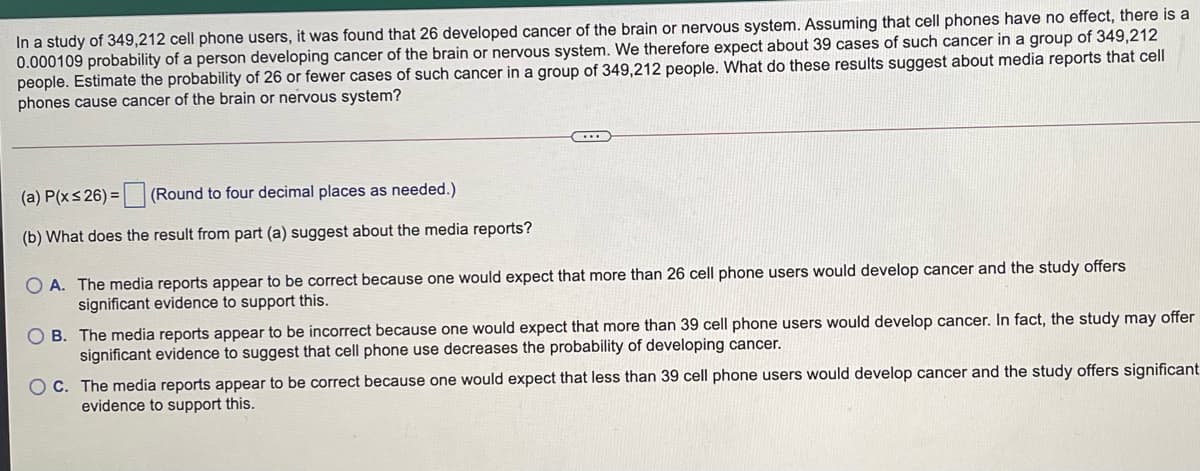In a study of 349,212 cell phone users, it was found that 26 developed cancer of the brain of hervouS systel 0.000109 probability of a person developing cancer of the brain or nervous system. We therefore expect about 39 cases of such cancer in a group of 349,212 people. Estimate the probability of 26 or fewer cases of such cancer in a group of 349,212 people. What do these results suggest about media reports that cell phones cause cancer of the brain or nervous system? (a) P(xs 26) = (Round to four decimal places as needed.) (b) What does the result from part (a) suggest about the media reports? O A. The media reports appear to be correct because one would expect that more than 26 cell phone users would develop cancer and the study offers significant evidence to support this. O B. The media reports appear to be incorrect because one would expect that more than 39 cell phone users would develop cancer. In fact, the study may offer significant evidence to suggest that cell phone use decreases the probability of developing cancer. OC. The media reports appear to be correct because one would expect that less than 39 cell phone users would develop cancer and the study offers significant evidence to support this.
In a study of 349,212 cell phone users, it was found that 26 developed cancer of the brain of hervouS systel 0.000109 probability of a person developing cancer of the brain or nervous system. We therefore expect about 39 cases of such cancer in a group of 349,212 people. Estimate the probability of 26 or fewer cases of such cancer in a group of 349,212 people. What do these results suggest about media reports that cell phones cause cancer of the brain or nervous system? (a) P(xs 26) = (Round to four decimal places as needed.) (b) What does the result from part (a) suggest about the media reports? O A. The media reports appear to be correct because one would expect that more than 26 cell phone users would develop cancer and the study offers significant evidence to support this. O B. The media reports appear to be incorrect because one would expect that more than 39 cell phone users would develop cancer. In fact, the study may offer significant evidence to suggest that cell phone use decreases the probability of developing cancer. OC. The media reports appear to be correct because one would expect that less than 39 cell phone users would develop cancer and the study offers significant evidence to support this.
Holt Mcdougal Larson Pre-algebra: Student Edition 2012
1st Edition
ISBN:9780547587776
Author:HOLT MCDOUGAL
Publisher:HOLT MCDOUGAL
Chapter11: Data Analysis And Probability
Section11.8: Probabilities Of Disjoint And Overlapping Events
Problem 2C
Related questions
Question

Transcribed Image Text:In a study of 349,212 cell phone users, it was found that 26 developed cancer of the brain or nervous system. Assuming that cell phones have no effect, there is a
0.000109 probability of a person developing cancer of the brain or nervous system. We therefore expect about 39 cases of such cancer in a group of 349,212
people. Estimate the probability of 26 or fewer cases of such cancer in a group of 349,212 people. What do these results suggest about media reports that cell
phones cause cancer of the brain or nervous system?
(a) P(xs 26) =
(Round to four decimal places as needed.)
(b) What does the result from part (a) suggest about the media reports?
O A. The media reports appear to be correct because one would expect that more than 26 cell phone users would develop cancer and the study offers
significant evidence to support this.
B. The media reports appear to be incorrect because one would expect that more than 39 cell phone users would develop cancer. In fact, the study may offer
significant evidence to suggest that cell phone use decreases the probability of developing cancer.
O C. The media reports appear to be correct because one would expect that less than 39 cell phone users would develop cancer and the study offers significant
evidence to support this.
Expert Solution
Step 1

Trending now
This is a popular solution!
Step by step
Solved in 3 steps with 3 images

Recommended textbooks for you

Holt Mcdougal Larson Pre-algebra: Student Edition…
Algebra
ISBN:
9780547587776
Author:
HOLT MCDOUGAL
Publisher:
HOLT MCDOUGAL


Holt Mcdougal Larson Pre-algebra: Student Edition…
Algebra
ISBN:
9780547587776
Author:
HOLT MCDOUGAL
Publisher:
HOLT MCDOUGAL
